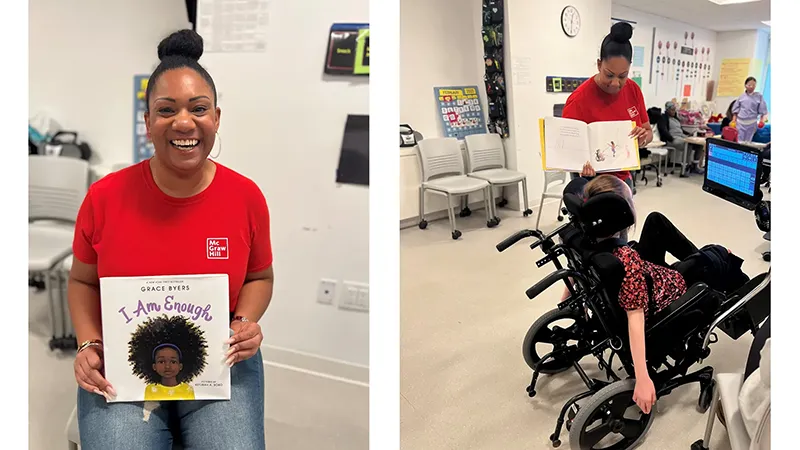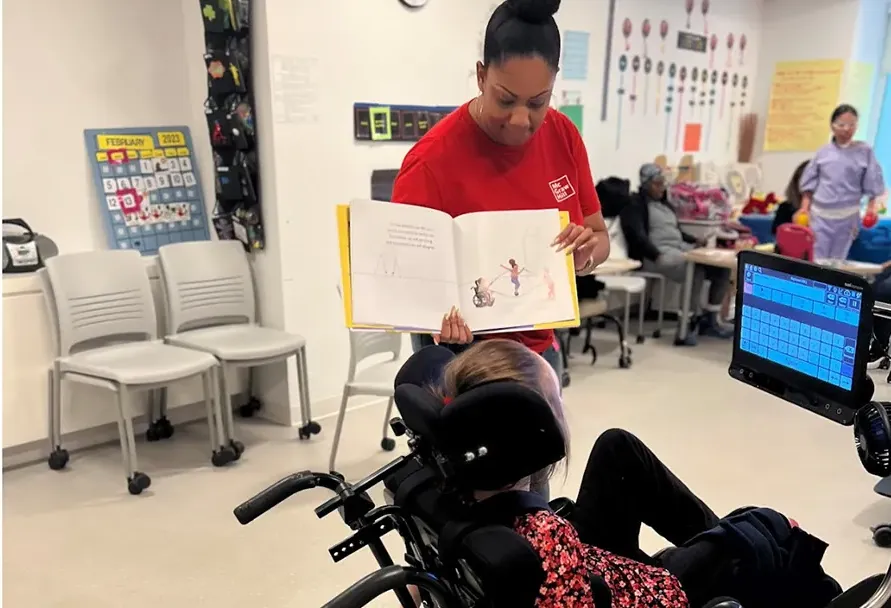My Account Details
Supporting learning without limits
How McGraw Hill employees are making learning accessible for all.
Accessibility is never far from Dominique Pickens’ mind. As a Senior Digital Academic Designer at McGraw Hill, she helps create online literacy products for school-age students.
But she discovered a new way to think about accessibility earlier this year when she volunteered at iHope Academy. Located down the street from McGraw Hill’s headquarters in New York City, iHope is a highly specialized school that exclusively serves students aged 5 to 21 who have traumatic brain injuries and are of varying abilities.
As Pickens read aloud to a group of students there, she couldn’t help but notice all the assistive technology they used to facilitate learning. Some were familiar. Others, like the eye gaze tracking device that allows students to “talk” using their eyes, were new to her. Seeing the role accessibility plays in a school like iHope left her feeling more motivated than ever to create content that meets the needs of all learners. “I’ll think about these students every time we discuss content development,” she says. “And I’ll push to make sure accessibility, equity and representation are always part of the conversation.”

Creating a level playing field for students
Pickens isn’t the only employee at McGraw Hill who’s keeping learning accessibility front of mind. Removing barriers to learning and teaching is the driving force behind all content and technologies we’re creating.
One of the latest examples of this is the continued development of a drag-and-drop activity type that can be authored and made compliant for higher education students. It’s the first of its kind to hit the market, says Emilie Berglund, Director of Accessibility Implementation for McGraw Hill’s Digital Platform Group.
Dragging and dropping is used frequently in digital materials. Consider an anatomy class where students are tasked with dragging labels from one part of the screen and dropping them on the corresponding parts of the body. With this new technology, all learners can engage in the activity. Depending on their needs, students can use a keyboard, voice input or a screen reader to complete the activity.
Berglund and her counterparts are also in the midst of ensuring all science content and experiences are accessible for students and teachers in the Texas K-12 school system. Whether a teacher is adding due dates to assignments or students are accessing content available on e-readers, all experiences must be compliant. And each and every update to support these experiences requires rounds of design, implementation and testing.
The work requires a great deal of empathy, which Berglund points out is at the very heart of accessibility. “Can you step into someone else's shoes? Can you respect their experience, understand it as valid as your own? And then can you allow that to shape the experience creation instead of shaping the experience for only your own needs?” she says. “It's not about me. It's about everyone.”
Giving back to learners
While accessibility is an everyday focus at McGraw Hill, many employees paid it special attention during our fourth annual Global Volunteer Week, held May 15-19, 2023. Some led virtual read-alouds in classrooms around the country. Others participated in a company-wide panel discussion about accessibility and ways to continue supporting all learners.
For her part, Pickens organized a day of volunteering at iHope. She and her colleagues read aloud to students and participated in a book drive for the school library. As much as she looks forward to giving back to the students, she was just as excited for her coworkers to see what accessibility looks like in action.

“I think any time we can get in the classroom and see how students are learning is a benefit for us,” she explains. “We can think about the products we build, how teachers use them, how students are interacting with them. A lot of our activities involve a white board. But when we’re at iHope, we can see if the teacher has time to use a board. Are they doing more small group activities instead? Seeing that live helps us be more intentional in the work we’re doing and meet students and teachers where they are.”